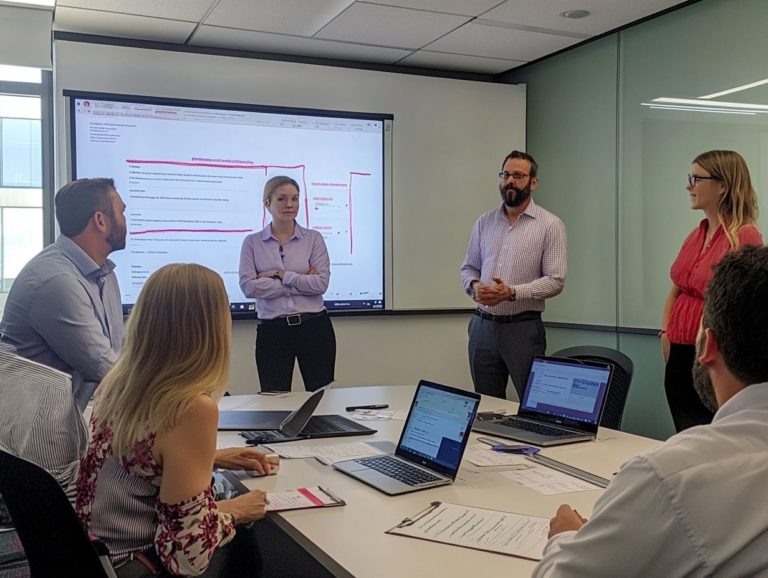How to Encourage Employee Ownership in Performance Management
Employee ownership transcends being a mere buzzword; it represents a transformative approach that has the potential to elevate both your employee satisfaction and organizational performance.
This exploration delves into the myriad benefits of helping employees feel they own their work. It outlines effective strategies for empowering your team, involving them in performance management, and setting clear, achievable goals.
This exploration also addresses challenges you may face. It offers effective solutions to ensure that every individual thrives within an ownership-driven environment.
By embracing employee ownership, you can unlock lasting success for both your team members and your organization as a whole!
Contents
- Key Takeaways:
- The Importance of Employee Ownership in Performance Management
- Ways to Foster Employee Ownership
- Incorporating Employee Input into Performance Management
- Setting Clear Expectations and Goals
- Providing Opportunities for Growth and Development
- Recognizing and Rewarding Ownership
- Handling Challenges in Employee Ownership
- Frequently Asked Questions
- What is the importance of encouraging employee ownership in performance management?
- How can I involve employees in setting their own performance goals?
- What are some ways to foster a culture of employee ownership in performance management?
- How can I support employees in taking ownership of their performance?
- What role does leadership play in encouraging employee ownership in performance management?
- How can I address any resistance to employee ownership in performance management?
Key Takeaways:

- Foster a culture of ownership by empowering employees to take charge of their performance and development.
- Incorporate employee input into performance management through methods like feedback surveys and regular check-ins.
- Set clear expectations and goals, provide opportunities for growth and development, and recognize and reward ownership to encourage a sense of ownership in employees.
The Importance of Employee Ownership in Performance Management
Employee ownership plays a crucial role in elevating performance management within your organization. It directly impacts economic outcomes, company performance, job stability, and the workplace culture.
By cultivating a sense of ownership among your employees, you can effectively mitigate financial risks. This also enhances job security and promotes a more collaborative sharing of insights and responsibilities.
When employees are more engaged, their ownership stakes increase. This leads to improved productivity and greater cooperative efforts, which ultimately bolster firm survival rates.
Programs such as US Employee Stock Ownership Plans, a program that allows employees to own shares in the company they work for, illustrate how strategically integrating employee ownership can yield positive effects both within the organization and in the broader community.
Benefits for Employees and Organizations
The benefits of employee ownership go far beyond just financial gains. They significantly enhance your job security, elevate your satisfaction, and contribute to the overall success of the organization while tackling economic inequality.
Worker cooperatives exemplify how financial participation nurtures a culture of shared responsibility and engagement. This results in a more motivated workforce.
With this heightened job satisfaction, turnover rates decrease, team morale flourishes, and economic outcomes for the organization improve.
When you embrace employee ownership, you can expect a notable boost in productivity. You and your colleagues become more invested in the company’s success!
Take The Mondragon Corporation, for example a federation of worker cooperatives in Spain. It showcases sustainable growth and resilience, even in tough economic times.
Research indicates that employee-owned firms are 4.6% more productive than their conventional counterparts. This difference is largely driven by higher levels of commitment and enthusiasm among team members.
This model not only builds wealth among employees, allowing you to share in profits and secure your financial future. It also fosters a genuine sense of belonging and community within the organization.
Ways to Foster Employee Ownership
Fostering an environment that encourages employee ownership demands a thoughtful approach. It’s important to cultivate a culture of ownership, complemented by policies that enhance both engagement and accountability.
You need to minimize financial risk by establishing clear pathways for employees to participate in decision-making processes. This ensures they feel a true sense of belonging and responsibility.
By implementing supportive policies, you can nurture an ownership culture. This aligns employee interests with organizational goals, ultimately driving greater success for everyone involved!
Creating a Culture of Ownership
Creating a culture of ownership requires a transformative approach to workplace dynamics. This approach involves aligning company rules with fostering positive employee behaviors and constructive management relations.
This means actively promoting a sense of shared responsibility and encouraging open communication. Both elements enhance employee engagement and overall organizational performance.
To implement this shift effectively, you should begin by clearly defining roles and responsibilities. Ensure that every team member understands their unique impact on organizational goals.
Providing opportunities for professional development gives the power to employees to take the initiative and contribute meaningfully.
Conducting regular feedback sessions cultivates a transparent environment where everyone feels valued and heard. This approach enhances trust.
As management embraces collaboration and demonstrates accountability, it nurtures a sense of belonging that further embeds an ownership mindset.
Ultimately, aligning ways to measure how well employees are doing with organizational objectives encourages each individual to view their contributions as integral to the company’s success.
Empowering Employees

Empowering yourself through increased participation and proactive initiatives enhances your job security. It also mitigates financial risks for your organization.
By investing in training programs and taking ownership of your role, you can contribute to a more engaged and motivated workforce that drives organizational success.
This dynamic approach encourages you to refine your skills. It fosters a culture of continuous learning and adaptability.
When you feel valued and included in decision-making processes, your loyalty and commitment naturally increase. This leads to higher retention rates.
Well-structured training initiatives equip you with the tools needed to navigate uncertainties. This reduces potential financial setbacks for the company.
By cultivating an environment that prioritizes participation and professional development, organizations can nurture a resilient workforce. This workforce is ready to tackle challenges head-on.
Incorporating Employee Input into Performance Management
Incorporating employee input into performance management is vital for cultivating a culture of corporate transparency. It also reduces issues between workers and management.
By implementing effective feedback mechanisms and actively engaging employees in decision-making processes, you can unlock valuable insights. These insights significantly enhance overall performance and job satisfaction.
This approach not only gives the power to employees but also fosters a more collaborative and productive work environment.
Methods for Gathering Feedback
Effective methods for gathering feedback are essential for enhancing employee engagement. They also foster positive management relations within your workplace culture.
- Anonymous surveys
- Regular check-ins
- Open-door policies
These techniques can facilitate constructive feedback, ultimately contributing to a more engaged workforce.
By utilizing anonymous surveys, you create a safe space for employees to share their thoughts without the fear of repercussions. This allows for honest and valuable insights.
Regular check-ins encourage ongoing dialogue. They enable managers to address concerns promptly while also nurturing relationships.
Both methods do come with challenges. Surveys might result in low response rates if not framed thoughtfully. Frequent check-ins may be viewed as micromanagement if not handled delicately.
Embracing a culture of transparency through open-door policies fosters trust. It requires a genuine commitment from leaders to actively listen and act on the feedback gathered.
This way, the dialogue transforms into meaningful change, enhancing the overall workplace experience.
Setting Clear Expectations and Goals
Setting clear expectations and goals is essential for fostering accountability. It positively shapes employee behaviors within your organization.
By implementing effective goal-setting strategies, you not only offer direction but also invite participation in decision-making. This cultivates a genuine sense of ownership among your team members.
Effective Goal-Setting Strategies
Implementing SMART goals (Specific, Measurable, Achievable, Relevant, Time-bound) helps structure your objectives and enhances employee engagement. This approach allows you to effectively track performance measures and aligns individual goals with the broader success of the organization.
By focusing on clear and actionable targets, you empower employees to understand their roles within the company’s mission. This clarity fosters a sense of ownership and drive, as team members see how their work directly influences outcomes.
Using goal-setting frameworks promotes open communication, ensuring that expectations are clear and achievable. Over time, these initiatives boost personal accountability and create a collaborative work environment that drives collective success for your organization.
Providing Opportunities for Growth and Development

Seize every opportunity for growth and development to boost employee engagement now! By investing in training programs and prioritizing skill development, you foster job satisfaction and cultivate a motivated workforce ready to face challenges.
Supporting Employee Growth and Learning
Supporting your employees’ growth and learning is vital for cultivating a proactive culture within your organization. By investing in comprehensive training programs, you empower your team to take charge of their own development, enhancing overall performance.
In today s fast-paced business environment, it’s crucial to acknowledge the essential role that continuous learning plays in engaging and retaining your workforce. Offering mentorship opportunities and access to online courses equips your team with vital skills and fosters loyalty and commitment. When you encourage employees to set personal development goals and pursue certifications, you show a long-term investment in their futures.
This intentional strategy boosts individual confidence and cultivates a vibrant workplace culture that values growth, adaptability, and innovation. Ultimately, this drives your organization toward sustained success.
Recognizing and Rewarding Ownership
Recognizing and rewarding ownership within your organization can significantly enhance employee motivation and strengthen accountability among team members.
By implementing effective incentives and recognition programs, you encourage financial participation and foster a culture of ownership that drives exceptional performance.
Incentives and Recognition Programs
Incentives and recognition programs are invaluable for boosting employee motivation and enhancing overall performance. By creating effective reward systems that align with your organization’s goals, you can cultivate a culture of accountability and engagement.
These programs can take many forms, from monetary bonuses and promotions to non-monetary recognitions like employee-of-the-month awards and public acknowledgments in meetings. Tailoring these initiatives to meet the diverse needs of employees can significantly improve morale and productivity.
Encouraging peer recognition, where employees acknowledge each other’s efforts, promotes collaboration and camaraderie. Additionally, performance-based incentives cultivate a spirit of healthy competition. A well-structured recognition program nurtures a positive workplace atmosphere that uplifts spirits and drives the organization toward achieving its strategic objectives.
Handling Challenges in Employee Ownership
Navigating the complexities of employee ownership requires a thoughtful approach to tackle resistance and overcome obstacles in labor-management relations. By cultivating a collaborative environment and improving workplace dynamics, you can effectively address these challenges and pave the way for successful employee ownership initiatives.
Addressing Resistance and Overcoming Obstacles

Addressing employee resistance is essential for successfully implementing ownership initiatives within your organization. By employing effective change management strategies that emphasize transparent communication and active employee involvement, you can significantly reduce resistance and encourage positive behaviors among your team.
To achieve this, prioritize building trust by providing regular updates that clearly outline the objectives and benefits of the ownership initiatives. Consider implementing training sessions that empower employees, equipping them with the skills they need to adapt to the changes.
Establishing feedback loops where employees can express their concerns enables you to tackle issues proactively. This approach allows for adjustments to strategies as needed.
Fostering a culture of participation and inclusion will align individual motivations with broader company goals, ultimately facilitating a smoother transition and promoting greater acceptance of employee ownership concepts.
Frequently Asked Questions
What is the importance of encouraging employee ownership in performance management?
Encouraging employee ownership in performance management allows employees to take charge of their own work and goals, leading to increased motivation, engagement, and accountability. Understanding the importance of employee input in performance management can further enhance this process.
How can I involve employees in setting their own performance goals?
Involve employees in setting their own performance goals through open and transparent communication. Encourage them to share their ideas and aspirations, and collaborate to create measurable and achievable goals.
What are some ways to foster a culture of employee ownership in performance management?
Fostering a culture of employee ownership can be achieved by promoting a growth mindset, providing regular feedback and recognition, and involving employees in decision-making processes.
How can I support employees in taking ownership of their performance?
Empower employees by providing the resources, tools, and training they need to succeed. Be available for guidance and support when necessary, and recognize and reward their efforts and achievements!
What role does leadership play in encouraging employee ownership in performance management?
Leaders play a crucial role in encouraging employee ownership. They should lead by example, communicate clear expectations, provide regular feedback and recognition, and create a supportive and empowering work environment.
How can I address any resistance to employee ownership in performance management?
If employees resist taking ownership of their performance, it’s important to understand and address any underlying issues or concerns. Encouraging open and honest communication and providing support and resources, such as a training on performance management tools, can help, while remaining patient throughout the process.
Ready to implement these strategies? Start today!





